Seat Leon 5D 2008 Service Manual
Manufacturer: SEAT, Model Year: 2008, Model line: Leon 5D, Model: Seat Leon 5D 2008Pages: 293, PDF Size: 8.67 MB
Page 41 of 293
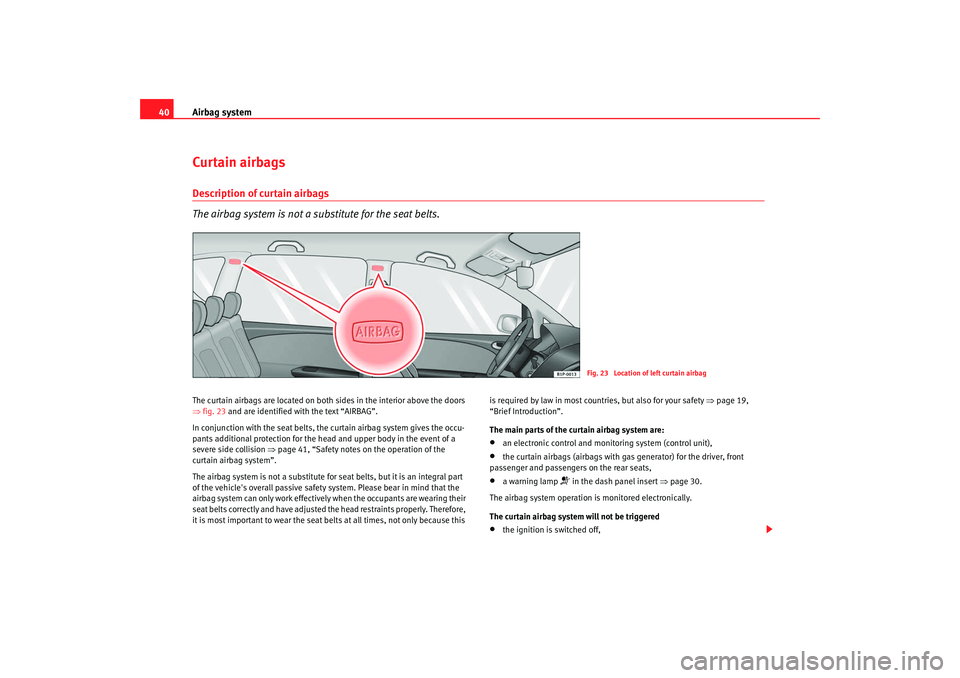
Airbag system
40Curtain airbagsDescription of curtain airbags
The airbag system is not a substitute for the seat belts.The curtain airbags are located on both sides in the interior above the doors
‚áí fig. 23 and are identified with the text ‚ÄúAIRBAG‚ÄĚ.
In conjunction with the seat belts, the curtain airbag system gives the occu-
pants additional protection for the head and upper body in the event of a
severe side collision ⇒ page 41, “Safety notes on the operation of the
curtain airbag system‚ÄĚ.
The airbag system is not a substitute for seat belts, but it is an integral part
of the vehicle's overall passive safety system. Please bear in mind that the
airbag system can only work effectively when the occupants are wearing their
seat belts correctly and have adjusted th e head restraints properly. Therefore,
it is most important to wear the seat belts at all times, not only because this is required by law in most countries, but also for your safety
‚áípage 19,
‚ÄúBrief Introduction‚ÄĚ.
The main parts of the curtain airbag system are:
‚ÄĘ
an electronic control and monitoring system (control unit),
‚ÄĘ
the curtain airbags (airbags with ga s generator) for the driver, front
passenger and passengers on the rear seats,
‚ÄĘ
a warning lamp
ÔĀī in the dash panel insert ‚áí page 30.
The airbag system operation is monitored electronically.
The curtain airbag system will not be triggered
‚ÄĘ
the ignition is switched off,
Fig. 23 Location of left curtain airbag
leon_ingles Seite 40 Montag, 26. Januar 2009 4:29 16
Page 42 of 293
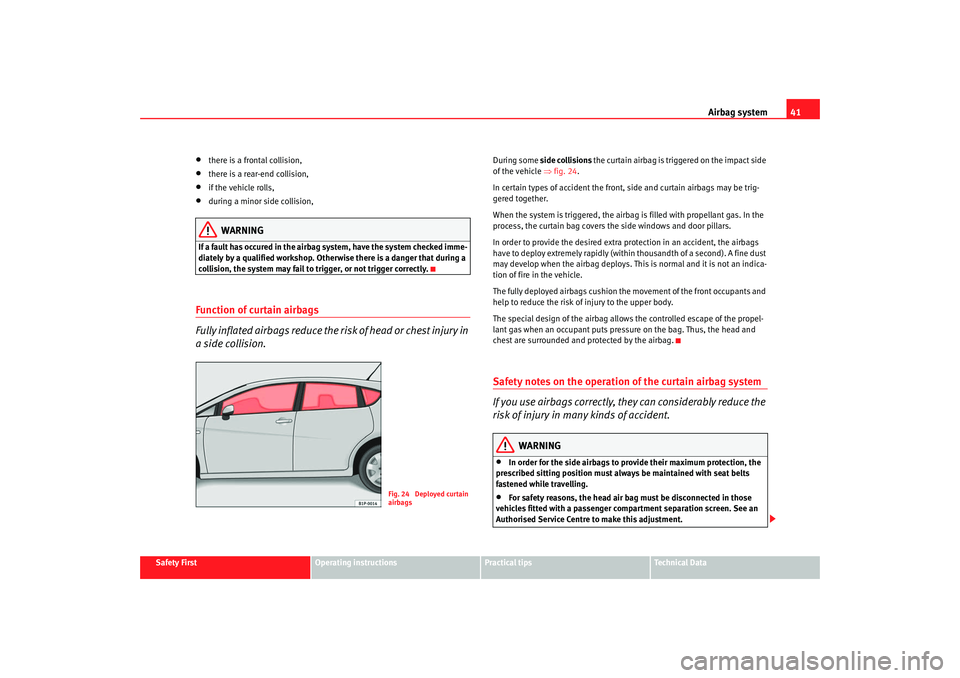
Airbag system41
Safety First
Operating instructions
Practical tips
Te c h n i c a l D a t a
‚ÄĘ
there is a frontal collision,
‚ÄĘ
there is a rear-end collision,
‚ÄĘ
if the vehicle rolls,
‚ÄĘ
during a minor side collision,
WARNING
If a fault has occured in the airbag system, have the system checked imme-
diately by a qualified workshop. Otherw ise there is a danger that during a
collision, the system may fail to trigger, or not trigger correctly.Function of curtain airbags
Fu ll y i n fl a ted a i rb ag s redu ce t h e r i s k o f h ea d o r ch est i n ju r y i n
a side collision.
During some side collisions the curtain airbag is triggered on the impact side
of the vehicle ‚áífig. 24.
In certain types of accident the front, side and curtain airbags may be trig-
gered together.
When the system is triggered, the airbag is filled with propellant gas. In the
process, the curtain bag covers the side windows and door pillars.
In order to provide the desired extra protection in an accident, the airbags
have to deploy extremely rapidly (withi n thousandth of a second). A fine dust
may develop when the airbag deploys. This is normal and it is not an indica-
tion of fire in the vehicle.
The fully deployed airbags cushion the movement of the front occupants and
help to reduce the risk of injury to the upper body.
The special design of the airbag allows the controlled escape of the propel-
lant gas when an occupant puts pressure on the bag. Thus, the head and
chest are surrounded and protected by the airbag.Safety notes on the operation of the curtain airbag system
If you use airbags correctly, they can considerably reduce the
risk of injury in many kinds of accident.
WARNING
‚ÄĘ
In order for the side airbags to provide their maximum protection, the
prescribed sitting position must always be maintained with seat belts
fastened while travelling.
‚ÄĘ
For safety reasons, the head air bag must be disconnected in those
vehicles fitted with a passenger compartment separation screen. See an
Authorised Service Centre to make this adjustment.
Fig. 24 Deployed curtain
airbags
leon_ingles Seite 41 Montag, 26. Januar 2009 4:29 16
Page 43 of 293
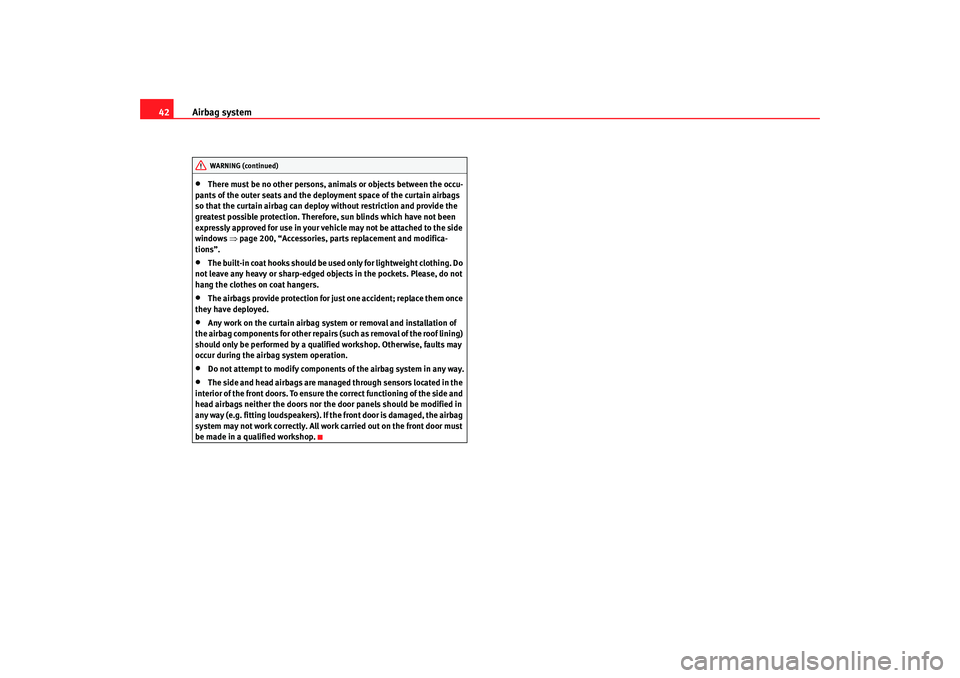
Airbag system
42‚ÄĘ
There must be no other persons, animals or objects between the occu-
pants of the outer seats and the deployment space of the curtain airbags
so that the curtain airbag can deploy without restriction and provide the
greatest possible protection. Therefore, sun blinds which have not been
expressly approved for use in your vehicle may not be attached to the side
windows ⇒ page 200, “Accessories, parts replacement and modifica-
tions‚ÄĚ.
‚ÄĘ
The built-in coat hooks should be used only for lightweight clothing. Do
not leave any heavy or sharp-edged objects in the pockets. Please, do not
hang the clothes on coat hangers.
‚ÄĘ
The airbags provide protection for just one accident; replace them once
they have deployed.
‚ÄĘ
Any work on the curtain airbag system or removal and installation of
the airbag components for other repairs (such as removal of the roof lining)
should only be performed by a qualified workshop. Otherwise, faults may
occur during the airbag system operation.
‚ÄĘ
Do not attempt to modify components of the airbag system in any way.
‚ÄĘ
The side and head airbags are managed through sensors located in the
interior of the front doors. To ensure the correct functioning of the side and
head airbags neither the doors nor the door panels should be modified in
any way (e.g. fitting loudspeakers). If the front door is damaged, the airbag
system may not work correctly. All work carried out on the front door must
be made in a qualified workshop.WARNING (continued)
leon_ingles Seite 42 Montag, 26. Januar 2009 4:29 16
Page 44 of 293
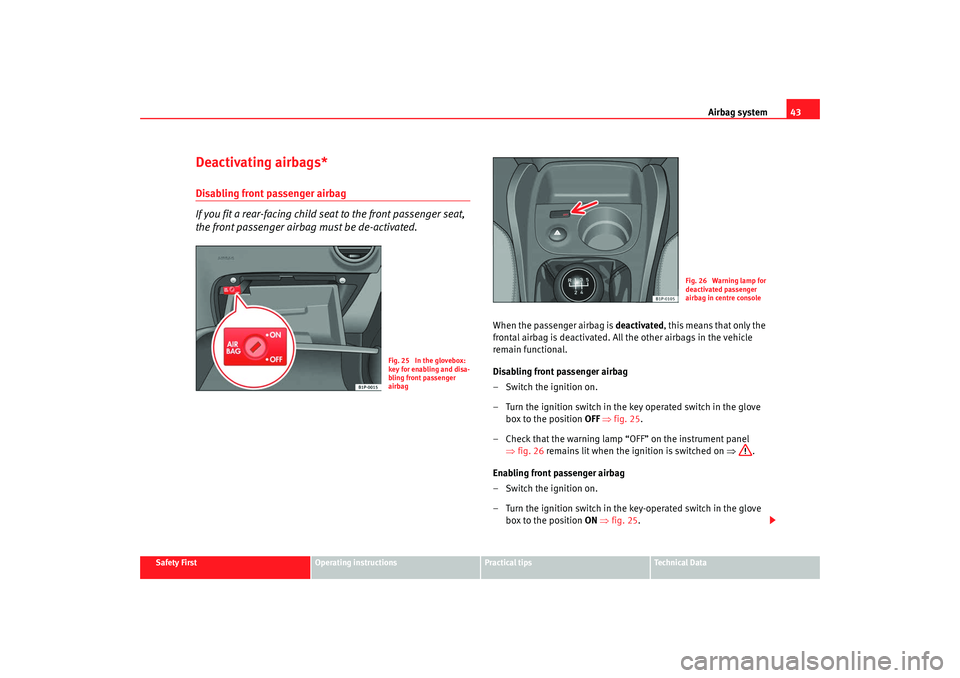
Airbag system43
Safety First
Operating instructions
Practical tips
Te c h n i c a l D a t a
Deactivating airbags*Disabling front passenger airbag
If you fit a rear-facing child seat to the front passenger seat,
the front passenger airbag must be de-activated.
When the passenger airbag is deactivated, this means that only the
frontal airbag is deactivated. All the other airbags in the vehicle
remain functional.
Disabling front passenger airbag
‚Äď Switch the ignition on.
‚Äď Turn the ignition switch in the key operated switch in the glove box to the position OFF ‚áí fig. 25 .
‚Äď Check that the warning lamp ‚ÄúOFF‚ÄĚ on the instrument panel ‚áífig. 26 remains lit when the ignition is switched on ‚áí.
Enabling front passenger airbag
‚Äď Switch the ignition on.
‚Äď Turn the ignition switch in the key-operated switch in the glove box to the position ON ‚áí fig. 25 .
Fig. 25 In the glovebox:
key for enabling and disa-
bling front passenger
airbag
Fig. 26 Warning lamp for
deactivated passenger
airbag in centre console
leon_ingles Seite 43 Montag, 26. Januar 2009 4:29 16
Page 45 of 293

Airbag system
44
‚Äď Check that the warning lamp on the instrument panel does ‚áípage 43, fig. 26 not light up when the ignition is switched on
‚áí .
WARNING
‚ÄĘ
The driver is responsible for the proper position of the key-operated
switch.
‚ÄĘ
You should deactivate the front passenger airbag only if you have to use
a rear-facing child seat in exceptional cases. ‚áípage 45, ‚ÄúChild safety‚ÄĚ.
‚ÄĘ
For those vehicles that do not include a key lock switch to turn the
airbag off, an Authorised Service Centre must be consulted.
‚ÄĘ
Never install a child seat facing backwards (or rear-facing) on the front
passenger seat unless the front passenger airbag has been disabled. This
represents a risk of fatal injuries to the child! However, if it is necessary in
exceptional circumstances to transport a child in a rear-facing child seat on
the front passenger seat, you must always disable the front passenger
airbag.
‚ÄĘ
As soon as the child seat is no longer needed on the front passenger
seat, enable the front passenger airbag again.
‚ÄĘ
Only deactivate the passenger airbag when the ignition is off, other-
wise a fault may occur in the airbag system, this will create a danger that
in case of an accident, the airbag does not deploy properly or does not
deploy at all.
‚ÄĘ
When the passenger airbag is deactivated, if the warning lamp AIRBAG
OFF is not continuously lit up when the front passenger airbag is disabled,
there may be a fault in the airbag system:
‚ąíHave the airbag system inspected immediately by a qualified work-
shop.
‚ąí Do not use a child seat on the front passenger seat! The front
passenger airbag could be triggered despite the fact that there is a fault in the system and, as a result, a child could sustain serious or fatal inju-
ries.
‚ąí
It is predictable whether the front passenger airbag will deploy
during an accident! Warn all your passengers of this.
‚ÄĘ
When using the ignition key to activate / deactivate the passenger front
airbag, only the passenger front airbag will be activated / deactivated. The
side airbag and head airbag on the passenger side will remain active.WARNING (continued)
leon_ingles Seite 44 Montag, 26. Januar 2009 4:29 16
Page 46 of 293

Child safety45
Safety First
Operating instructions
Practical tips
Te c h n i c a l D a t a
Child safetyBrief introductionIntroduction
Statistics show that children are generally safer on the rear
seat than on the front passenger seat.We recommend that children under 12 years of age are transported on the
rear seats. Children travelling on th e rear seat must use a child restraint
system or the seat belts provided, depending on their age, height and
weight. For safety reasons, the child r estraint system should be installed in
the centre of the rear seat or behind the front passenger's seat.
The physical laws involved and the forces acting in a collision apply also to
children ‚áípage 20, ‚ÄúWhy wear seat belts?‚ÄĚ.
But unlike adults, children do not ha ve muscle and bone structures fully
developed. This means that children are subject to a greater risk of injury.
To reduce this risk, children must always use special child restraint systems
when travelling in the vehicle.
We recommend the use of child safety products from the SEAT Genuine Acces-
sories Program including systems for all ages made by ‚ÄúPeke‚ÄĚ
2).
These systems have been especially designed and approved, complying with
the ECE-R44. regulation.
Follow the manufacturer's instructions and observe any statutory require-
ments when installing and using child seats. Always read and observe
‚áí page 46. We recommend you to include together
with the on-board documentation,
the manufacturer's Child Se at instructions manual.
2)Not for all countries
leon_ingles Seite 45 Montag, 26. Januar 2009 4:29 16
Page 47 of 293

Child safety
46Safety notes on using child seats
Proper use of child seats substantially reduces the risk of
injury in an accident!As the driver, you are responsible for any children you transport in
your vehicle.
‚Äď Protect your children by properly using appropriate child seats
‚áípage 47.
‚Äď Always ensure that the belt webbing is properly positioned according to the instructions prov ided by the manufacturer of the
child seat.
‚Äď When travelling, do not allow children to distract you from traffic.
‚Äď Take breaks regularly during long trips. Take a break at least every two hours.
WARNING
‚ÄĘ
Never install a child seat facing backwards (or rear-facing) on the front
passenger seat unless the front passenger airbag has been disabled. This
could lead to a risk of potentially fatal in juries to the child! However, if it is
necessary, in exceptional cases, to transport a child in the front passenger
seat, the front passenger airbag must always be disabled ‚áípage 43,
‚ÄúDeactivating airbags*‚ÄĚ. If the passe nger seat has a height adjustment
option, move it to the highest position.
‚ÄĘ
For those vehicles that do not include a key lock switch to turn the
airbag off, an Authorised Service Centre must be consulted.
‚ÄĘ
All passengers, especially children, must assume the proper sitting
position and be properly belted in while travelling.
‚ÄĘ
Never hold children or babies on your lap, this can result in potentially
fatal injuries to the child!
‚ÄĘ
Never allow a child to be transported in a vehicle without being properly
secured, or to stand up or kneel on a seat while travelling. In an accident,
the child could be flung through the vehicle, causing possibly fatal injuries
to themselves and to the other passengers.
‚ÄĘ
If children assume an improper sitting position when the car is moving,
they expose themselves to greater risk of injury in the event of sudden
braking manoeuvre or in an accident. This is particularly important if the
child is travelling on the front passenger seat and the airbag system is trig-
gered in an accident; as this could cause serious injury or even death.
‚ÄĘ
A suitable child seat can protect your child!
‚ÄĘ
Never leave an unsupervised child alone on a child seat or in the
vehicle.
‚ÄĘ
Depending on weather conditions, it may become extremely hot or cold
inside the vehicle. This can be fatal.
‚ÄĘ
Children who are less than 1.5 metres tall must not wear a normal seat
belt without a child restraint system, as this could cause injuries to the
abdominal and neck areas during a sudden braking manoeuvre or in an
accident.
‚ÄĘ
Do not allow the belt webbing to become twisted or jammed, or to rub
on any sharp edges.
‚ÄĘ
Incorrectly worn seat belts can cause injuries even in a minor collision
or in sudden braking manoeuvres.
‚ÄĘ
The seat belt provides maximum prot ection only when the belt web is
properly positioned ‚áí page 23, ‚ÄúSeat belts‚ÄĚ.
‚ÄĘ
Only one child may occupy a child seat ‚áípage 47, ‚ÄúChild seats‚ÄĚ.WARNING (continued)
leon_ingles Seite 46 Montag, 26. Januar 2009 4:29 16
Page 48 of 293
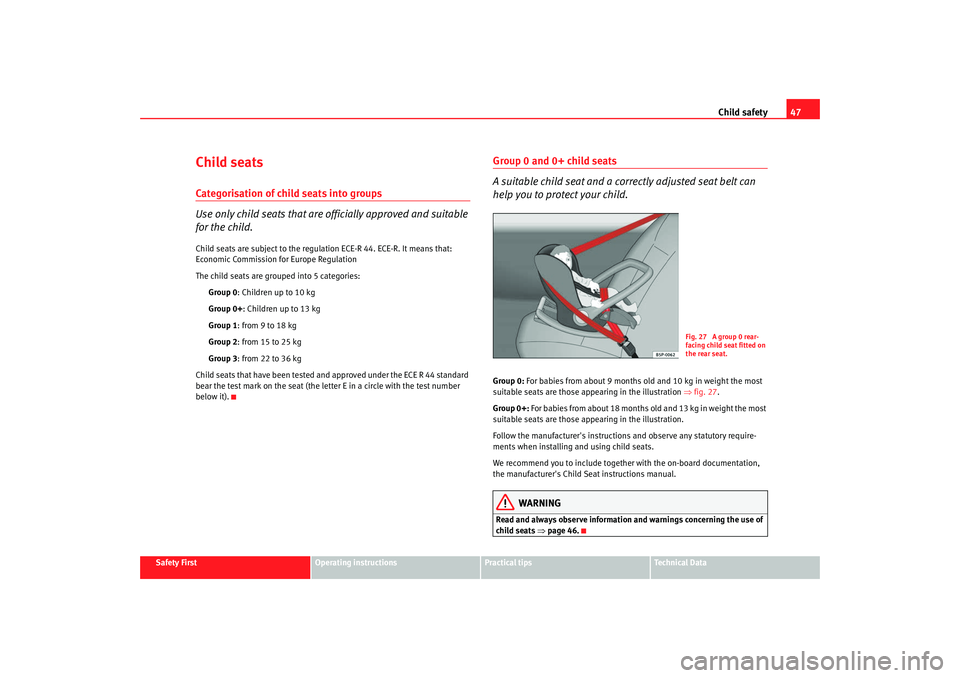
Child safety47
Safety First
Operating instructions
Practical tips
Te c h n i c a l D a t a
Child seatsCategorisation of child seats into groups
Use only child seats that are officially approved and suitable
for the child.Child seats are subject to the regulation ECE-R 44. ECE-R. It means that:
Economic Commission for Europe Regulation
The child seats are grouped into 5 categories:
Group 0: Children up to 10 kg
Group 0+ : Children up to 13 kg
Group 1: from 9 to 18 kg
Group 2: from 15 to 25 kg
Group 3: from 22 to 36 kg
Child seats that have been tested and approved under the ECE R 44 standard
bear the test mark on the seat (the letter E in a circle with the test number
below it).
Group 0 and 0+ child seats
A suitable child seat and a corr ectly adjusted seat belt can
help you to protect your child.Group 0: For babies from about 9 months old and 10 kg in weight the most
suitable seats are those ap pearing in the illustration ‚áífig. 27 .
Group 0+: For babies from about 18 months old and 13 kg in weight the most
suitable seats are those ap pearing in the illustration.
Follow the manufacturer's instructio ns and observe any statutory require-
ments when installing and using child seats.
We recommend you to include together with the on-board documentation,
the manufacturer's Child Se at instructions manual.
WARNING
Read and always observe information and warnings concerning the use of
child seats ‚áípage 46.
Fig. 27 A group 0 rear-
facing child seat fitted on
the rear seat.
leon_ingles Seite 47 Montag, 26. Januar 2009 4:29 16
Page 49 of 293
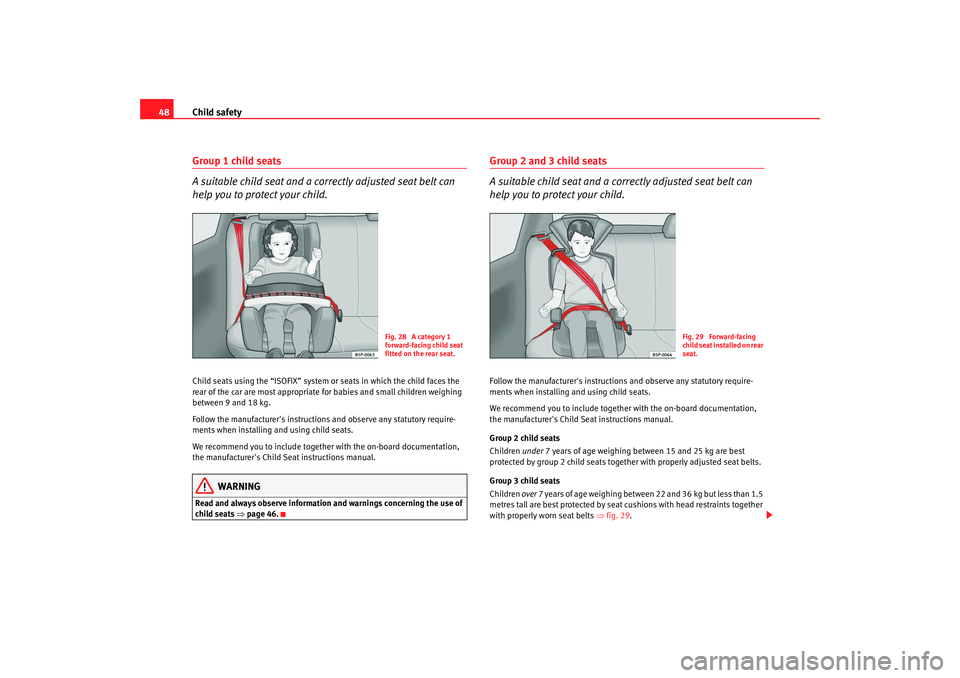
Child safety
48Group 1 child seats
A suitable child seat and a corr ectly adjusted seat belt can
help you to protect your child.Child seats using the ‚ÄúISOFIX‚ÄĚ system or seats in which the child faces the
rear of the car are most appropriate for babies and small children weighing
between 9 and 18 kg.
Follow the manufacturer's instructions and observe any statutory require-
ments when installing and using child seats.
We recommend you to include together with the on-board documentation,
the manufacturer's Child Seat instructions manual.
WARNING
Read and always observe information and warnings concerning the use of
child seats ‚áí page 46.
Group 2 and 3 child seats
A suitable child seat and a corr ectly adjusted seat belt can
help you to protect your child.Follow the manufacturer's instructions and observe any statutory require-
ments when installing and using child seats.
We recommend you to include together with the on-board documentation,
the manufacturer's Child Seat instructions manual.
Group 2 child seats
Children under 7 years of age weighing between 15 and 25 kg are best
protected by group 2 child seats together with properly adjusted seat belts.
Group 3 child seats
Children over 7 years of age weighing between 22 and 36 kg but less than 1.5
metres tall are best protected by seat cushions with head restraints together
with properly worn seat belts ‚áífig. 29 .
Fig. 28 A category 1
forward-facing child seat
fitted on the rear seat.
Fig. 29 Forward-facing
child seat installed on rear
seat.
leon_ingles Seite 48 Montag, 26. Januar 2009 4:29 16
Page 50 of 293
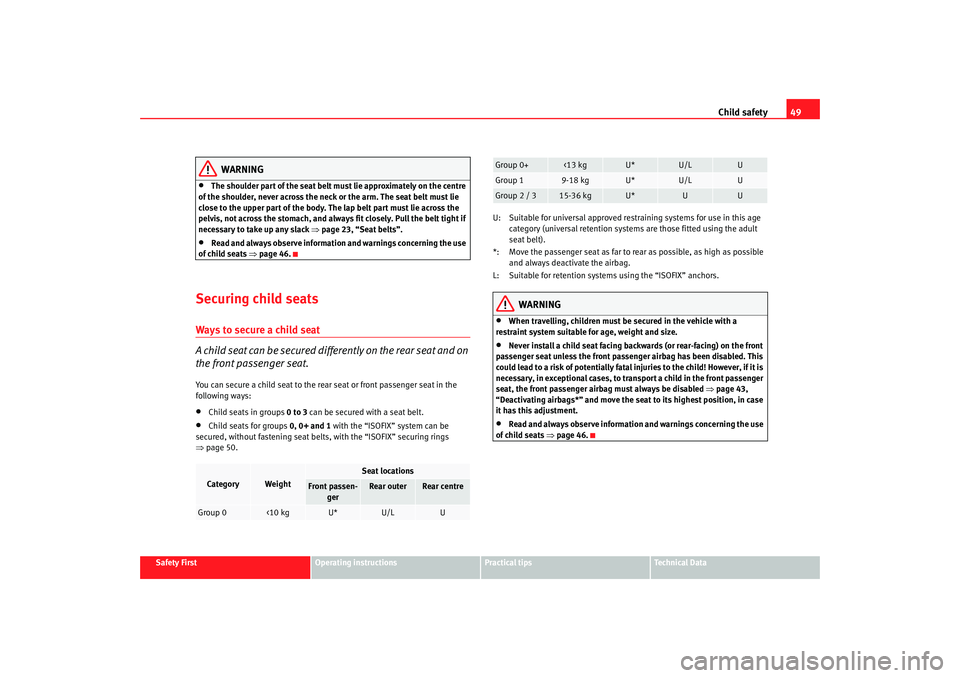
Child safety49
Safety First
Operating instructions
Practical tips
Te c h n i c a l D a t a
WARNING
‚ÄĘ
The shoulder part of the seat belt mu st lie approximately on the centre
of the shoulder, never across the neck or the arm. The seat belt must lie
close to the upper part of the body. The lap belt part must lie across the
pelvis, not across the stomach, and always fit closely. Pull the belt tight if
necessary to take up any slack ‚áípage 23, ‚ÄúSeat belts‚ÄĚ.
‚ÄĘ
Read and always observe information and warnings concerning the use
of child seats ‚áípage 46.
Securing child seatsWays to secure a child seat
A child seat can be secured differently on the rear seat and on
the front passenger seat.You can secure a child seat to the rear seat or front passenger seat in the
following ways:‚ÄĘ
Child seats in groups 0 to 3 can be secured with a seat belt.
‚ÄĘ
Child seats for groups 0, 0+ and 1 with the ‚ÄúISOFIX‚ÄĚ system can be
secured, without fastening seat belts, with the ‚ÄúISOFIX‚ÄĚ securing rings
‚áí page 50. U: Suitable for universal approved restraining systems for use in this age
category (universal retention systems are those fitted using the adult
seat belt).
*: Move the passenger seat as far to rear as possible, as high as possible and always deactivate the airbag.
L: Suitable for retention systems using the ‚ÄúISOFIX‚ÄĚ anchors.
WARNING
‚ÄĘ
When travelling, children must be secured in the vehicle with a
restraint system suitable for age, weight and size.
‚ÄĘ
Never install a child seat facing backwards (or rear-facing) on the front
passenger seat unless the front passenger airbag has been disabled. This
could lead to a risk of potentially fatal injuries to the child! However, if it is
necessary, in exceptional cases, to transport a child in the front passenger
seat, the front passenger airbag must always be disabled ‚áípage 43,
‚ÄúDeactivating airbags*‚ÄĚ and move the seat to its highest position, in case
it has this adjustment.
‚ÄĘ
Read and always observe information and warnings concerning the use
of child seats ‚áípage 46.
Category
Weight
Seat locations
Front passen-
ger
Rear outer
Rear centre
Group 0
<10 kg
U*
U/L
U
Group 0+
<13 kg
U*
U/L
U
Group 1
9-18 kg
U*
U/L
U
Group 2 / 3
15-36 kg
U*
U
U
leon_ingles Seite 49 Montag, 26. Januar 2009 4:29 16